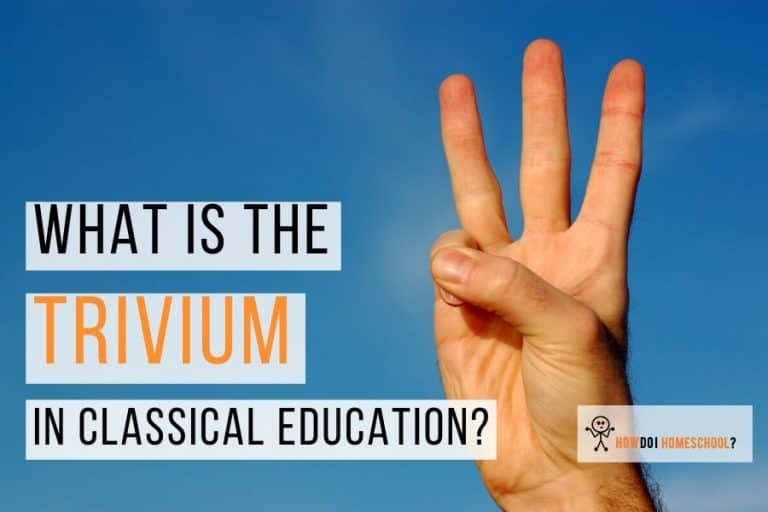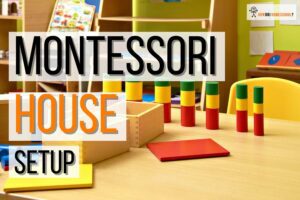The trivium in classical education is a set of three phases comprised of the grammar, logic, and rhetoric stages in which children first learn knowledge, then understanding, and finally wisdom. The trivium, part of the seven liberal arts, was first used in antiquity and then adapted to suit medieval Christian times.
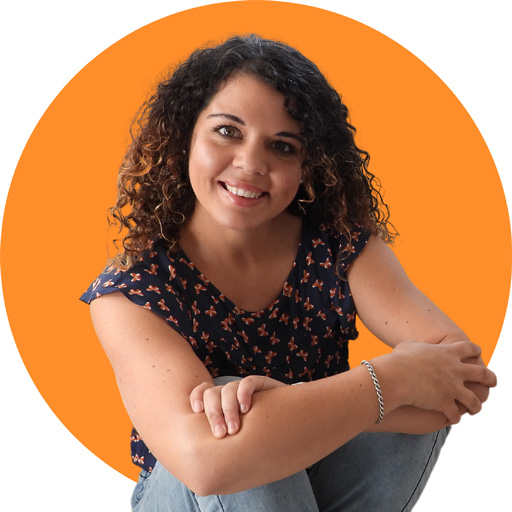
I hope you enjoy reading this blog post. If you want to do my course on how to homeschool, click here.
It eventually fell into disuse as modern educators fell in love with the plethora of subjects available to them. Only recently has it become popular again, especially among Christian educators, teachers, and homeschooling parents alike.
In this article, we’ll discuss the three stages of the trivium in detail and discuss why it is the best way to educate children. We’ll look at how classical education teaches children according to developmental stages: poll-parrot in the grammar stage, pert in the logic stage, and poetic in the rhetoric stage.
Let’s get started!
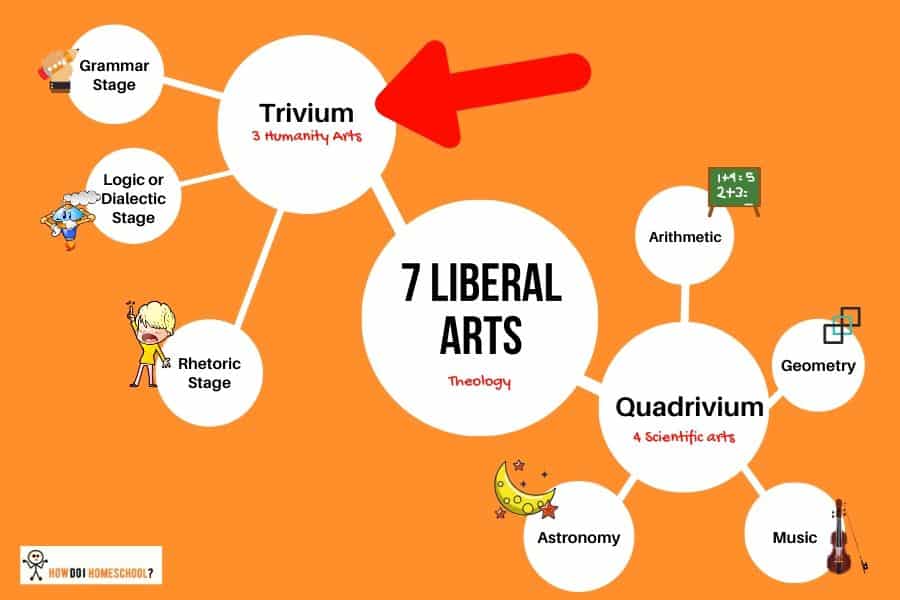
Some of the links in this post are affiliate links. This means if you click on the link and purchase the item, I will receive an affiliate commission at no extra cost to you.
What Does Trivium Mean?
The word trivium means three roads or three ways. Each ‘road’ of the trivium gives children the tools for learning differently compared to modern traditional education as seen in public schools.
What are the Stages of the Trivium in Classical Education?
The three stages of the trivium in classical education are the grammar stage, the logic stage, and the rhetoric stage. This is what Douglas Wilson, author of The Case for Classical Christian Education, said about the trivium stages:
This view of the Trivium assumes the course of study [that is, grammar, then logic, then rhetoric] to be chronological. First, we have grammar – the accumulation of factoids. Then comes dialectic – the sorting out of facts into truth and goodness. Then rhetoric is the presentation of that truth and goodness in a lovely form. – p. 133.
The grammar stage teaches raw facts to children through memorization, rote learning, and books. Children love to learn plain facts at this age, even though they don’t know their implications or all about them. In this phase, we teach children Latin to have a more holistic understanding of words and their origins. Educators may also encourage children to learn an additional Romantic language alongside Latin.
The logic or dialectic stage teaches children to understand the facts they learned in the grammar stage. Here we continue the study of Latin, which aids them in defining their terms. We also introduce them to debating techniques to make a point logically.
The rhetoric stage is the last, and high-school-aged students learn to present facts and logically-formed arguments in a persuasive and winsome manner.
Let’s go into these stages of the trivium in more detail below. (You can also watch the video below, which explains the trivium more.)
Grammar Stage
The first stage of the trivium in classical education is the grammar stage. Children are in primary school at this stage and are at a stage of life when they love repeating jingles and memorizing things. The mother of modern classical Christian education, Dorothy Sayers, called this the poll parrot stage.
We give them many facts to memorize and learn, which they will find helpful tools for learning later in the trivium’s second two stages.
In this phase, children also learn the Latin language, continuing in the logic stage. They learn the Latin language as Latin helps them understand the meaning of English words more precisely. This will then help them define their terms in the next dialectic stage.
Logic Stage (Dialectic)
The second stage of the trivium is the logic stage or dialectic. In middle to high school, children enter a phase of life where they are argumentative. Dorothy Sayers called this the pert stage.
Here they learn logic and understanding through debate and argumentative essays. They learn to define their terms so there will be no misunderstanding. Often they read newspapers or magazines, trying to discern bad arguments from good.
They continue learning Latin in this stage which helps them understand the meaning behind their words.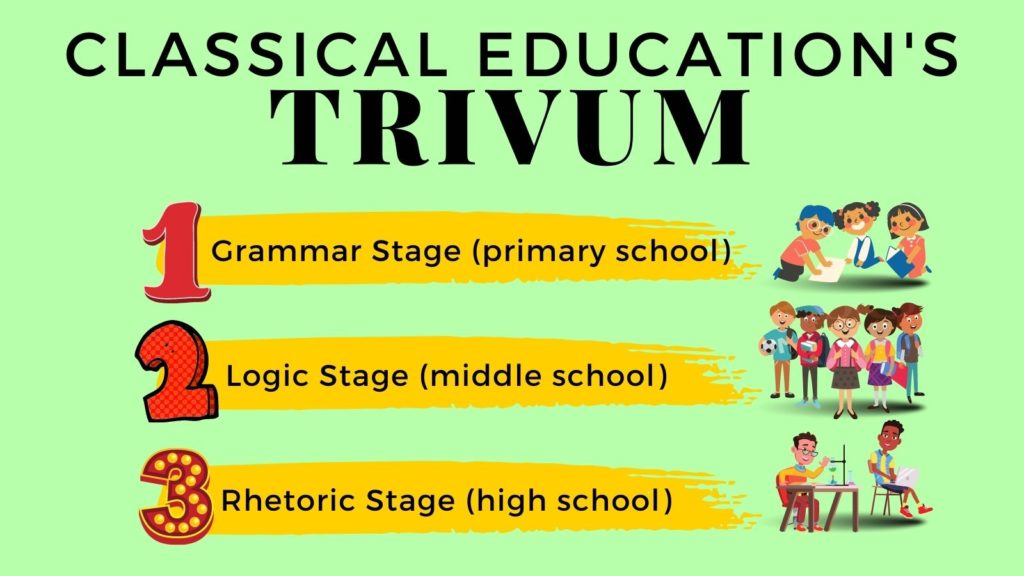
Rhetoric Stage
The third stage of the trivium is the rhetoric stage. Students in high school learn to communicate with wisdom and poise. Quintilian, a famous rhetorician, described this stage as teaching a ‘good man to speak well.’
Therefore, we continue teaching students to debate in this stage, but we start teaching them wisdom in their speech. We teach them how to talk for the listener’s benefit and appealingly deliver their content, making their listeners want to listen to them.
After the trivium, the quadrivium can be entered. This is usually a set of subjects in a tertiary institution that values classical education. The trivium and quadrivium together are called the 7 Liberal Arts. This is what Dorothy Sayers had to say about the scope of the rhetoric stage:
Rhetoric’s scope also depends on whether the pupil is to be turned out into the world at the age of sixteen or whether to proceed to public school and university. Since Rhetoric should be taken at about fourteen, the first category of pupil should study Grammar from about nine to eleven, and Dialectic from twelve to fourteen; his last two school years would then be devoted to Rhetoric, which, in his case, would be of a fairly specialized and vocational kind, suiting him to enter immediately upon some practical career. A pupil of the second category would finish his Dialectical course in his Preparatory School and take Rhetoric during his first two years at his Public School. At sixteen, he would be ready to start upon those “subjects” proposed for later study at the university; this part of his education will correspond to the mediæval Quadrivium. This means that the ordinary pupil, whose formal education ends at sixteen, will take the Trivium only, whereas scholars will take both the Trivium and Quadrivium. – Dorothy Sayers, Lost Tools of Learning, pp. 16-17.
As such, the scope of the rhetoric stage of the trivium in classical education can vary depending on whether the student wishes to proceed to college or not.
Developmental Stages in the Trivium (Parrot, Pert, and Poetic)
The trivium is supposed to be particularly effective as it teaches children according to their current developmental stage. It’s worth having Dorothy Sayers tell us what these phases are in her own language:
I recognize in myself three states of development. These, in a rough-and-ready fashion, I will call the Poll-parrot, the Pert, and the Poetic—the latter coinciding, approximately, with the onset of puberty. The Poll-parrot stage is the one in which learning by heart is easy and, on the whole, pleasurable, whereas reasoning is difficult and, on the whole, little relished. At this age, one readily memorizes the shapes and appearances of things; one likes to recite the number-plates of cars; one rejoices in the chanting of rhymes and the rumble and thunder of unintelligible polysyllables; one enjoys the mere accumulation of things. The Pert age, which follows upon this (and, naturally, overlaps it to some extent), is only too familiar to all who have to do with children: it is characterized by contradicting, answering-back, liking to “catch people out” (especially one’s elders), and the propounding of conundrums (especially the kind with a nasty verbal catch in them). Its nuisance value is exceptionally high. It usually sets in about the Lower Fourth. The Poetic age is popularly known as the “difficult” age. It is self-centered; it yearns to express itself; it rather specializes in being misunderstood; it is restless and tries to achieve independence; and, with good luck and good guidance, it should show the beginnings of creativeness, a reaching-out towards a synthesis of what it already knows, and a deliberate eagerness to know and do some one thing in preference to all others. Now it seems that the Trivium’s layout adapts itself with a singular appropriateness to these three ages: Grammar to the Poll-parrot, Dialectic to the Pert, and Rhetoric to the Poetic age. – Lost Tools of Learning, p. 9.
Teaching with the grain means children can learn plenty of facts at a stage of life when they love doing this but stop when they enter another phase. Teaching with the grain is the name of the game here.
Why Not Teach Using Modern Methods?
Why should we ‘reinvent’ the wheel and go against modern teaching theory? If you’re like me, you might despair when seeing the lack of eloquence many children have with words these days. They seem to lack the ability to think deeply or logically use words.
Today we teach lots of facts, but we don’t teach children how to use those facts knowledgeably or with wisdom. As such, we leave students at the mercy of newspapers and other writings. Instead, we need to give children tools to learn that helps them recognize truth from falsehood and illogical arguments from well-formed ideas:
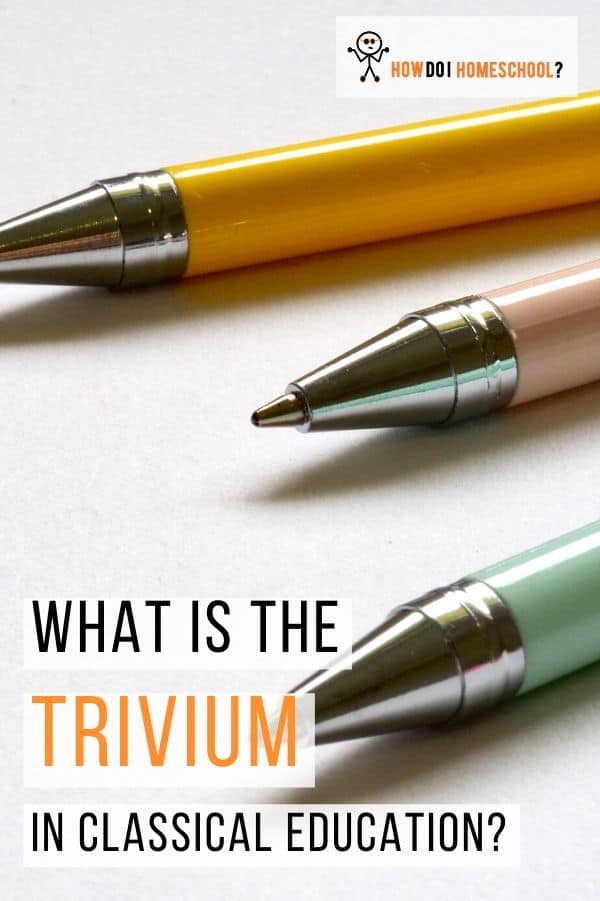
[T]o-day a great number—perhaps the majority—of the men and women who handle our affairs, write our books and our newspapers, carry out research, present our plays and our films, speak from our platforms and pulpits—yes, and who educate our young people, have never, even in a lingering traditional memory, undergone the scholastic discipline. Less and less do the children who come to be educated bring any of that tradition with them. We have lost the tools of learning—the ax and the wedge, the hammer and the saw, the chisel and the plane—that were so adaptable to all tasks. Instead of them, we have merely a set of complicated jigs, each of which will do but one task and no more, and in using which eye and hand receive no training, so that no man ever sees the work as a whole or “looks to the end of the work.” – Dorothy Sayers, Lost Tools of Learning, p. 18.
On this topic, Sayers also said:
Have you ever followed a discussion in the newspapers or elsewhere and noticed how frequently writers fail to define the terms they use? Or how often, if one man does define his terms, another will assume in his reply that he was using the terms in precisely the opposite sense to that in which he has already defined them? Have you ever been faintly troubled by the amount of slipshod syntax going about? And if so, are you troubled because it is inelegant or because it may lead to dangerous misunderstanding? – Lost Tools of Learning, pp. 2-3.
As such, the trivium’s three stages equips students with better educational tools than modern techniques that often only teach facts without analysis.
Where Does Theology Fit Into the Trivium in Classical Education?
For the pagan and the Christian, the trivium was supposed to have an absolute, holistic, and complete influence on every aspect of the student’s life, forming their thoughts, actions, and habits. This is why Plato effectively said, ‘Give me a child up to age seven, and I’ll form them into whatever you like.’
Douglas Wilson, an influencer in classical Christian education, called this ‘paedia.’
For the Christian, theology draws all subjects together as all things find their meaning ultimately in God. The Bible says the beginning of knowledge is the fear of God. Therefore, Christian theology says you cannot know anything without knowing God first.
I believe this is obvious even to many people who aren’t Christian. Tara Isabella Burton said this:
“In many ways, a course in theology is an ideal synthesis of all other liberal arts: no longer, perhaps, “Queen of the Sciences,” but at least, as Wood terms it, “Queen of the Humanities.” ” -‘Study Theology, Even if You Don’t Believe in God‘
Quadrivium vs. Trivium in Classical Education
Trivium means ‘three roads’ or three ways. Quadrivium means ‘four roads’ or four ways.
As outlined in the diagram at the beginning of this article, the quadrivium sits apart from the trivium. It is usually done after the trivium in a tertiary institution. Whereas the trivium might be described better as phases or stages (grammar, logic, and rhetoric), the quadrivium is probably better described as a set of subjects instead of phases.
The trivium gives children the tools for learning (knowledge, understanding, and wisdom), and the quadrivium is a set of subjects to which those tools are applied.
The trivium and quadrivium together make up the 7 Liberal arts.
The Trivium refers to the first three of the seven liberal arts and consists of grammar, dialectic, and rhetoric. Just as the word classical expands out in many directions, so does the word Trivium. Within the Trivium, the constituent parts are enormous subjects in their own right. – Douglas Wilson, The Case for Classical Christian Education, p. 132.
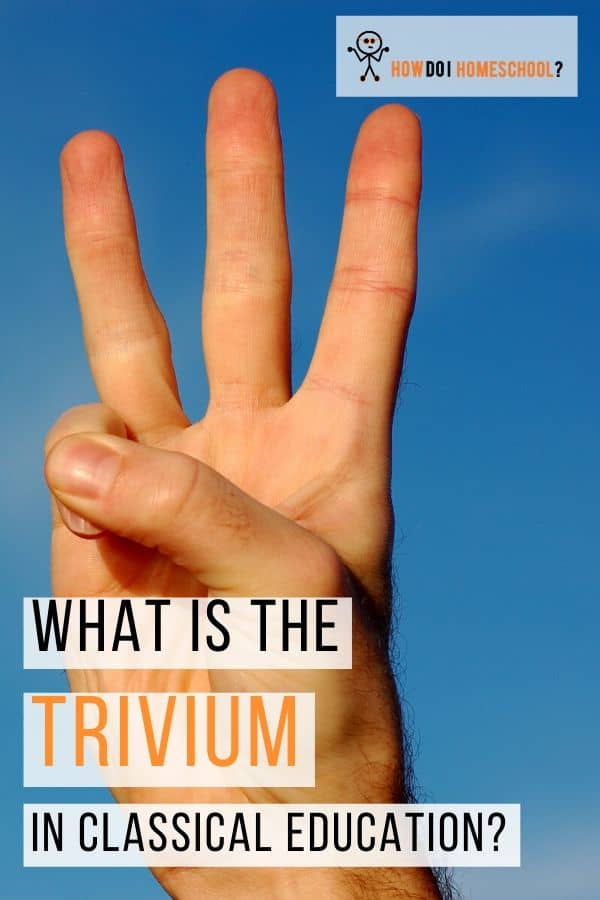
How to Get a Classical Education Curriculum for a Homeschool
There are plenty of good Classical education curriculum options around like:
- Memoria Press,
- Classical Conversations,
- Veritas Press and
- My Father’s World (a mix between classical and Charlotte Mason education).
I’ve looked into several of these options which can be found reviewed here.
Further Reading on the Trivium in Classical Education
- Lost Tools of Learning by Dorothy Sayers. It’s a must-read for anyone considering classical Christian education. You can hear it on Youtube here.
- The Case for Classical Christian Education by Douglas Wilson. It will help you understand Classical Christian education today in the school context.
I’ve quoted from both texts in this article as I’ve wanted to go back to the original source of modern classical education.
Want to Learn How to Homeschool?
There are two great ways t learn more about homeschooling: one is free, and one is a $67 fundamentals course.
The $67 Course
Looking to take your homeschooling to the next level? Join Rebecca Devitt’s online Homeschool Parenting Program and learn the strategies and techniques needed to make homeschooling a success! Learn more about the HPP here and signup here.
The Free Youtube Channel
Also, make sure you join the How to Homeschool Youtube channel, which will give you a fun and exciting look into the homeschool world and help homeschool your children. Check out the channel here, and don’t forget to SUBSCRIBE.
If you’re not sure where to start, start with the following playlists:
- Starting homeschool playlist
- Homeschool Methods playlist
- Homeschool Curriculum playlist
- FAQs on Homeschooling playlist
You’ll love it and find it helpful and entertaining! Discover the channel here.
Conclusion
Compared to modern educational teaching methods, the trivium in classical education gives students the tools for learning which they can use for subsequent subjects they study or just for an intelligent analysis of everyday life. The trivium equips children to recognize logical fallacies and doesn’t leave them helpless at the hands of the media or other publications. The trivium in classical Christian education gives children context for life as it incorporates theology into all subjects. As such, an education in the classics prepares students well for life in today’s world.
